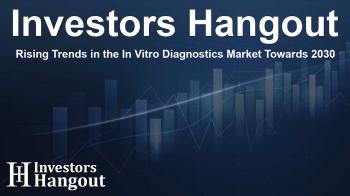Rising Trends in the In Vitro Diagnostics Market Towards 2030

Exploring the Future of In Vitro Diagnostics
The in vitro diagnostics market is on a trajectory to reach an impressive USD 150.13 billion by 2030, showcasing a compound annual growth rate (CAGR) of 5.62% from 2025 to 2030. This growth is driven by several dynamic factors, including the aging population and significant technological advancements in diagnostics, which have transformed healthcare delivery. The market's evolution emerged largely from the COVID-19 pandemic's impact, spurring both innovation and accelerated adaptation of diagnostic technologies.
Key Drivers of Market Growth
Technological advancements significantly contribute to the market surge. Innovations such as enhanced portability and accuracy of diagnostic instruments, combined with cost-effectiveness, are pivotal. The pandemic notably prompted a quicker rollout of in vitro diagnostic tools, such as PCR testing, thereby streamlining processes for healthcare providers and patients alike.
Furthermore, diagnostic companies are forming partnerships and agreements continuously to streamline their operations and enhance market presence. This collaborative approach helps to navigate the complexities of supply chains while ensuring robust delivery of essential diagnostic solutions to healthcare facilities.
Challenges and Opportunities in Market Dynamics
Despite the optimistic outlook, the in vitro diagnostics market grapples with challenges, particularly surrounding the price containment strategies employed by government laboratories. These strategies can create financial constraints that impact the supply chain complexities and profitability for manufacturers.
The prevalence of chronic diseases, including cancer and cardiovascular diseases, drives demand for innovative diagnostic solutions to facilitate early detection and better patient outcomes. As consumer needs continue to escalate, the emergence of novel technologies, such as plasmonic PCR, promises to change the landscape of diagnostic options available in the near future.
Market Insights and Highlights
The in vitro diagnostics market is characterized by remarkable innovation stemming from ongoing progress in various diagnostic fields, including molecular diagnostics and point-of-care testing. The market's operational efficiency is significantly influenced by distribution channels critical to ensuring products reach healthcare providers effectively.
Market Segmentation Overview
The in vitro diagnostics market can be segmented into several key areas. Products include instruments and reagents, with reagents expected to dominate with a considerable market share driven by substantial R&D investments. Each segment showcases diverse technological applications catering to a wide range of medical needs.
Regional Trends
Regionally, the North American sector leads the market, accounting for a substantial share. Its position is bolstered by innovative infrastructure and robust healthcare systems, which favor the deployment of advanced diagnostic tools. Conversely, emerging markets in Asia-Pacific are catching up, showing significant growth potential due to increasing healthcare investments.
Competitive Landscape
As the industry evolves, key players continuously adapt to maintain market leadership. Companies like Abbott, Bio-Rad Laboratories, and Siemens Healthineers are at the forefront of driving innovation and competition. Their focused efforts on developing cutting-edge technologies and expanding product lines play crucial roles in capturing market share.
The evolving landscape necessitates that these corporations invest in advanced technologies to meet the growing demands of healthcare professionals and patients alike, thus ensuring they remain competitive in this fast-paced market environment.
Conclusion
The in vitro diagnostics market is set for a transformative journey towards 2030, with technological advancements and a heightened focus on patient outcomes steering its direction. As innovations emerge and the market adapts, the ultimate goal remains clear: to enhance diagnostics for better healthcare delivery. The industry's evolution promises not only growth but also an exciting array of opportunities for future breakthroughs.
Frequently Asked Questions
What factors are contributing to the growth of the in vitro diagnostics market?
The growth is primarily driven by an aging population, technological advancements, and the increasing prevalence of chronic diseases that require effective diagnostics.
How does the COVID-19 pandemic impact the in vitro diagnostics field?
The pandemic accelerated the adoption of diagnostic tools, especially PCR testing, significantly transforming the market landscape and enhancing the demand for innovative solutions.
What are the main challenges facing the in vitro diagnostics market?
Key challenges include the complexity of supply chains and price containment strategies that can impact profitability for manufacturers.
Which regions are leading in the in vitro diagnostics market?
North America currently dominates the market due to its advanced healthcare infrastructure, while Asia-Pacific shows significant growth potential.
Who are the major players in the in vitro diagnostics industry?
Major players include Abbott, Bio-Rad Laboratories, Siemens Healthineers, and F. Hoffmann-La Roche, all of which are heavily invested in R&D and innovation.
About The Author
Contact Hannah Lewis privately here. Or send an email with ATTN: Hannah Lewis as the subject to contact@investorshangout.com.
About Investors Hangout
Investors Hangout is a leading online stock forum for financial discussion and learning, offering a wide range of free tools and resources. It draws in traders of all levels, who exchange market knowledge, investigate trading tactics, and keep an eye on industry developments in real time. Featuring financial articles, stock message boards, quotes, charts, company profiles, and live news updates. Through cooperative learning and a wealth of informational resources, it helps users from novices creating their first portfolios to experts honing their techniques. Join Investors Hangout today: https://investorshangout.com/
The content of this article is based on factual, publicly available information and does not represent legal, financial, or investment advice. Investors Hangout does not offer financial advice, and the author is not a licensed financial advisor. Consult a qualified advisor before making any financial or investment decisions based on this article. This article should not be considered advice to purchase, sell, or hold any securities or other investments. If any of the material provided here is inaccurate, please contact us for corrections.

